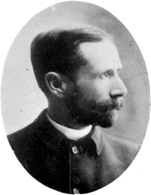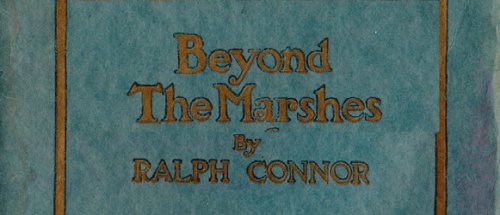Charles W. Gordon, 1860-1937
Born at Indian Lands, Glengarry County, Ontario on 13 September 1860, son of the Reverend Daniel Gordon and Mary Robertson, he was educated at public schools at Athol and Harrington, Ontario (1871), St. Mary’s High School (1879), University of Toronto (1883), Knox College (1887), and the New College, Edinburgh (1887-1888). He took a bicycle tour of Europe in 1888.

Gordon taught school in early life; was Classical Master, Chatham High School, 1887; Master, Upper Canada College, Toronto, 1886-1887. Post Graduate work at New College, Edinburgh, Scotland; travelled as a Missionary in the Canadian Rockies in 1890-94; travelled in the old country as Commissioner for Presbyterian Missions in Canada. In August 1894, he was called to St. Stephen’s Presbyterian Church. Was Moderator of the General Assembly of the Presbyterian Church in Canada. Overseas with the Canadian Expeditionary Force in the First World War in the Chaplain Service.
One of Canada’s most popular authors written under the pen name of Ralph Connor, of the following books:
- Black Rock, 1898
- Sky Pilot, 1899
- Man from Glengarry, 1901
- Glengarry School Days, 1902
- The Prospector, 1904
- The Rock and the River, 1931
- Gwen, an idyll of the Canyon, 1914
- The Doctor, 1906
- The Gaspards of Pine Croft, 1907
- Life of James Robertson, 1908
- The Foreigner, 1909
- The Patrol of the Sun Dance Trail, 1914
- Postscript to Adventure: the autobiography of Ralph Connor, 1938
On 28 September 1888, he married Helen Skinner King (1875-1961, daughter of John Mark King) with whom he had seven children: John King Gordon, Mary Robertson Gordon (1902-1948, wife of Humphrey Stephen Carver), Gretta Helen Gordon, Lois Isobel Gordon (1906-2003), Ruth Gordon, Margaret Helen “Marjorie” Gordon (1911-1982, wife of Edward Kenneth Smart), and Alison Iona Gordon (1915-1988, wife of Ronald Cox).
His grand home at 54 West Gate was designed by architect George William Northwood. His recreations included driving, canoeing, and camping. In 1910 he was listed by the Winnipeg Telegram as one of Winnipeg’s 19 millionaires. He received the King George V Jubilee Medal (1935) and an honorary doctorate by the University of Manitoba (1937).
Scholars study him today less for his craftsmanship than for his attitudes, many of which were quite typical of much of middle-class Anglophone Canada. An ardent imperialist, he was an enthusiastic patriot in the First World War, and undertook many fundraising and speaking tours during the conflict. He was also an early enthusiastic cottager at Lake of the Woods. His autobiography was published as Postscript to Adventure (1938).
He died at Winnipeg on 31 October 1937 and was buried in the Kildonan Presbyterian Cemetery.
The above excerpt from the Manitoba Historical Society
Beyond the Marshes
Published in 1900 by Ralph Connor, this short pastoral tale is beautifully illustrated with art nouveau designs.

Ralph Connor & his million dollar sermons
A Maclean's article from 15 November 1953 by Beth Paterson, relates the details about the successful writing career of Charles W. Gordon

The career of Ralph Connor
In a Maclean's article from April 1913 by Harris L. Adams, he details insights into the writings of Charles W. Gordon.

